British India Steam Navigation Co MS Dilwara
Please Note: Firefox and some other search engines are not
suitable – Use “Internet Explorer” for this page to load perfectly!
Click the logo above to reach
the ssMaritime FrontPage for News Updates & “Ship of the Month”
Maritime Historian, Cruise‘n’Ship
Reviewer, Author & Maritime Lecturer
Please Note: All ssMaritime and other related maritime/cruise sites
are 100% non-commercial and privately owned. Be assured that I am NOT
associated with any shipping or cruise companies or any travel/cruise agencies
or any other organisations! Although the author has been in the passenger
shipping industry since 1960, although is now retired but having completed
around 680 Classic Liners and Cargo-Passengers Ships
features I trust these will continue to provide classic ship enthusiasts
the information the are seeking, but above all a great deal of pleasure!
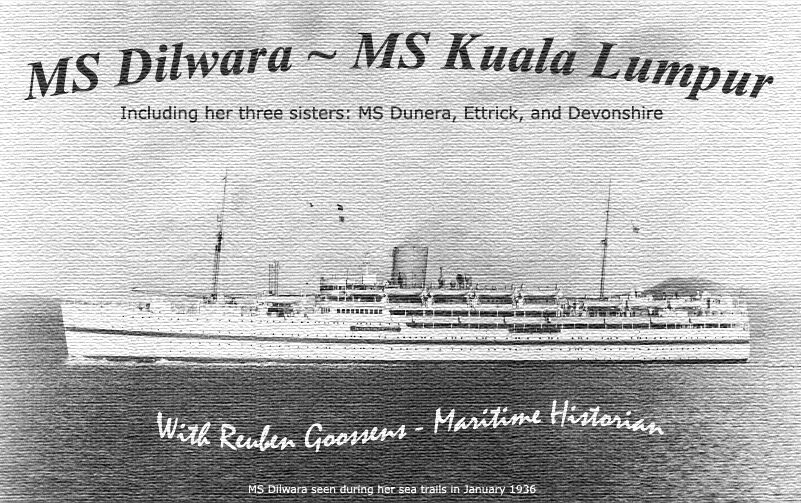
Please Note: Photographs on this page are from the author’s private
collection, unless stated otherwise.
Part One
Introduction
This feature is mostly about the MS Dilwara,
the ship which was sold to the China Navigation Co (CNCo) of
However, we will commence with the fascinating
beginnings of the famed British India Steam Navigation Co, and the quartet
being the subject of this article, and then on “Part Two” we will
cover the second life of the MS Dilwara as the MS Kuala Lumpur!
The Quartet are as follows, as
well as the MS Kuala Lumpur, ex Dilwara
MS Devonshire (later
BI’s - MS Devonia)
MS Kuala Lumpur (ex MS Dilwara) on Part (page)
Two
******************************
In
brief - The beginnings of a Legendary Company!
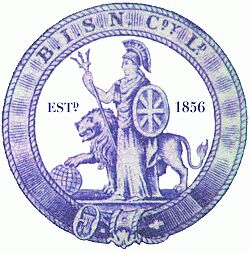
British India Steam Navigation Co has a long and an esteemed history as the founder Mr. William Mackinnon (born in Campbeltown Scotland) made his first contact with India in 1847 and it was when he was there that he encouraged his friend another Campbeltown native Mr. Robert Mackenzie to join him and seek their future together which culminated in the establishment of the company first known as “The Calcutta & Burmah Steam Navigation Co Ltd,” which was registered in Glasgow on September 24, 1856.
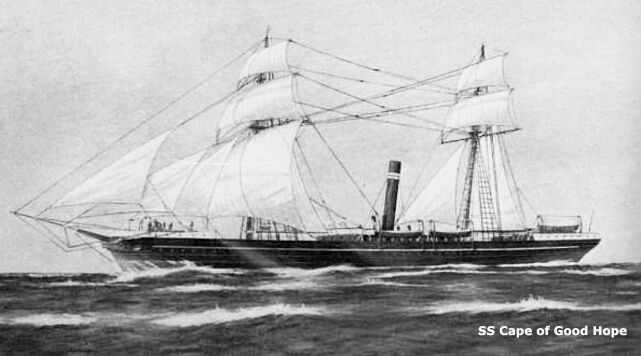
One of the
company’s first ships was the schooner the 1853 built, 420 GRT (Gross Registered Tons) SS
Not long after she
commenced successful operations, in 1861 the British India Steam Navigation
Company Ltd., came into being, and the company grew from strength to strength
operating a vast number of ships and since the thirties as passenger liners,
troop, and hospital, cruise, and student ships. In this feature we will deal
with four very special ships, one of which became one of the best known on two
sides of the globe, as well as a greatly loved ship, the first of the quartet
to be built the MS Dilwara, later the MS Kuala Lumpur of the China Navigation
Co, of
******************************
1. MS Dilwara
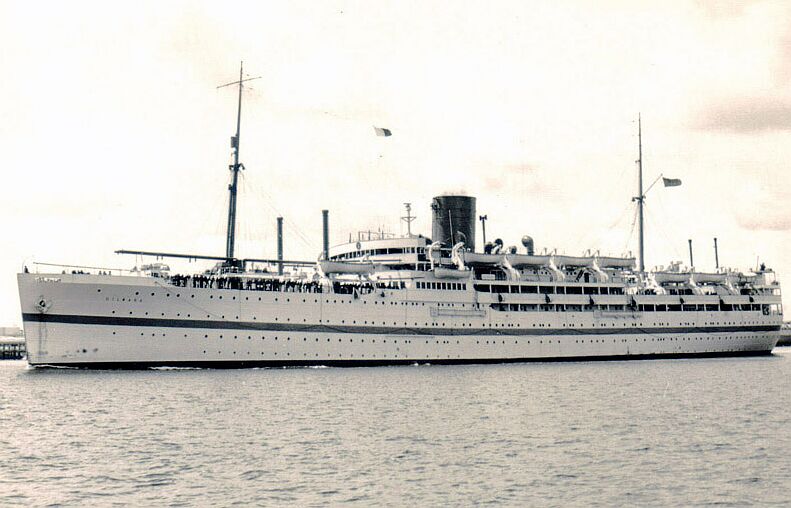
MS Dilwara seen here earlier in her career
How a new quartet of ships came to be:
In the mid 1930’s the British Government decided to sponsor a quartet of ships to operate as troopers. Although purpose built as troopers, these ships would also be adaptable to operate budget cruises, and thus it was decided that the design would be based on one of BI’s current passenger liners, but a vastly improved and larger version of the 1926 built 8,704 GRT SS Rajula, which remained in service with BI until sold in 1973 to Shipping Corporation of India when she was renamed SS Rangat, but was laid up in India in 1974, and broken up the very next year.
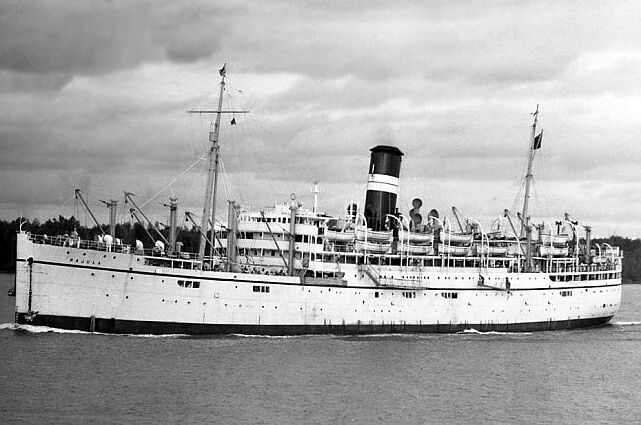
SS Rajula seen in the late 1950’s
*Photographer unknown
– sent in by a supporter. Please see photo notes at bottom of page
These four ships
were purpose built as troop and passenger ships between
Although these ships would be built using all the latest techniques and finest materials, all four ships WERE remarkably Spartan offering bland interiors, for mass-transport having barrack style accommodation and mess-halls for some 1150 troops. However, there were some premier accommodations on board in two classes being First and Second Class, as well as additional accommodations for troop family members in comfortable, but basic cabins for four, six or eight. First Class was generally reserved for the high ranking officers and their families, and Second Class for the lesser ranking ones, whilst the third category for the accompanying direct family members of soldiers on board.
Each ship had five
deep holds and were able to hold around 12,000 cubic ft of cargo as well as
military equipment and stores. But, these ships were essentially passenger
ships, and it was for this reason that
The first two
ships, MS Dilwara and Dunera were completed in 1936 and 1937 and the second
pair MS Ettrick and
MS Dilwara and her
engines were built by Barclay Curle & Company in
However – troublesome
times were on the horizon!
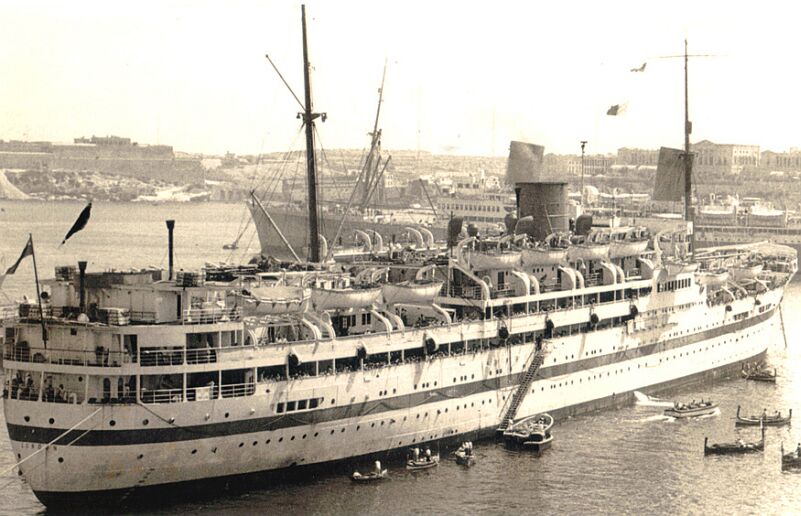
A stern view of MS Dilwara with the
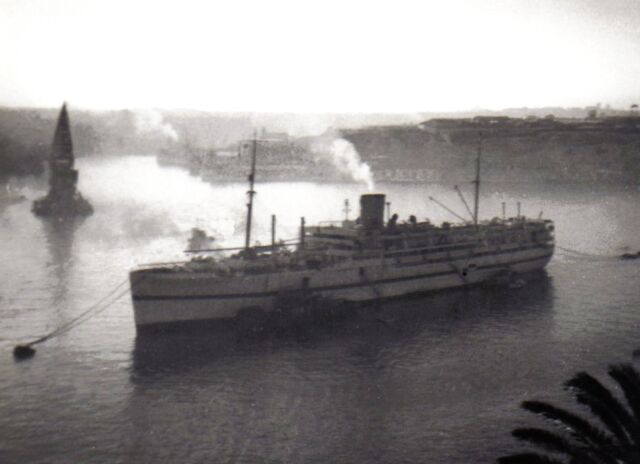
Dilwara is seen at anchor at
*Photographer unknown – sent in by a supporter.
Please see photo notes at bottom of page
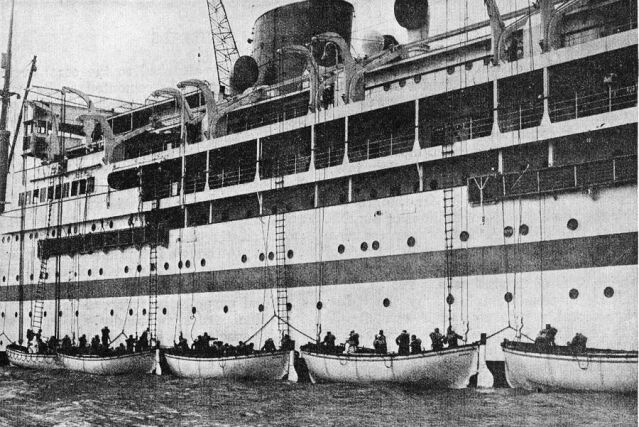
Life boat drill was a regular occurrence and
strictly observed
World War II.
Some time prior to
the war years the Dilwara had already commenced to operate a full time trooping
duties from
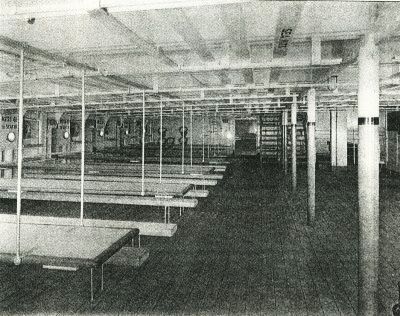
Here is an image of the rather Spartan troop mess
hall
Provided by Stan Evans –
Some notable events:
HMS Dilwara took
part in HRH King George VI's Coronation Review. In April 1941 she took part in
the evacuation from
The HMS Dilwara
was also involved in the
1952 Refit:
Thankfully the
Dilwara came out of the war without any major damage and in 1952 it was decided
to give her a comprehensive refit and she was to be well and truly modernised.
Thus she headed for the
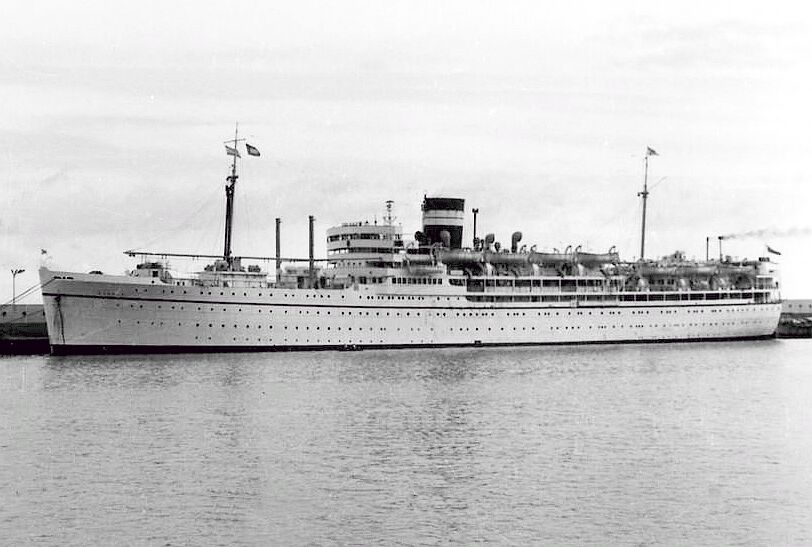
MS Dilwara seen in her latter years with the BI
funnel - spending more time as a student cruise ship
However, the MS
Dilwara was purchased in September 1960 by the China Navigation Co, of
The MS Kuala Lumpur story will be continued on “Part Two” –
see the Index at the bottom of the page.
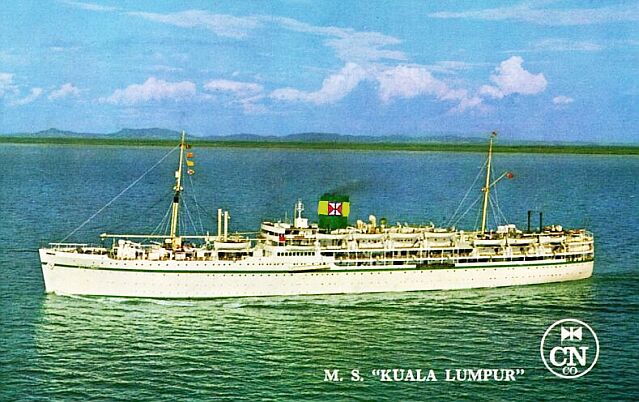
Postcard
of the MS Kuala Lumpur in her later years, showing the Swire flag on her green
funnel
Specifications
- MS Dilwara & Dunera:
Builder: Barclay
Curle & Company
Yard No. Dilwara – 654 / Dunera
– 663
Launched: Dilwara – October 17, 1935 / Dunera
– May 10, 1937
Length: 157.53m / 516.9ft.
Beam: 19.81m /
63ft.
Draught: 7.4m.
Displacement: 11,080 GRT
(Gross Registered Tons), 6,553 Net, 3,435 DWT.
Engines: 2 x
Doxford, Opposed Pistons, 5 Cylinder, 2S, CSA, Diesels by Barclay Curle.
Horsepower: 11,880 BHP.
Screws: Two.
Speed: 14.5 knots
service speed, 16 max.
Passengers:
Dilwara: 104 First Class,
100 Second Class, 164 troops' families & 1150 troops (1936-52).
125
First Class, 96 Second Class, 104 Third & 705 Troops (1952-60).
Dunera: 123 First Class,
96 Second Class, 100 Third & 835 Troops (1951-61).
190 in Cabins & 800 in Dormitories. (1961-67).
******************************
2. MS Dunera
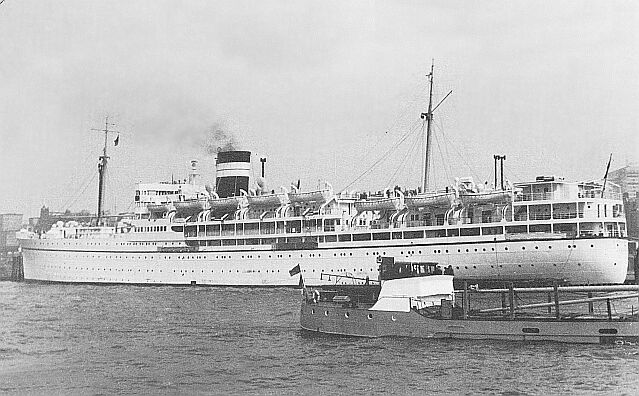
MS
Dunera is seen here operating as a school-cruise ship in 1961
The MS Dunera was the second of the quartet to be built and she also was specifically designed as a troopship and built by Barclay Curle & Co, Glasgow in 1937. Like her sister she had the one yellow funnel, two masts, diesel engines and twin screws.
She was launched on May 10, 1937
When the war had finished she continued on her
trooping duties, mostly to
In 1951 she was given a comprehensive refit which saw her tonnage change to 12,615 and she had new and more stylish accommodations for 123 First, 96 Second, 100 Third as well as 835 beds in the new dormitories, that replaced the old “barracks”. These would be used by troops and student cruises. She continued on her usual voyages to the Middle East and Asia until January 1961, when the Dunera was decommissioned from trooping in 1961, as she was being replaced, much like the Dilwara had been a year earlier, by the new TSS Oxfordshire and Nevasa. However, BI did decide to retain her and give her another refit.
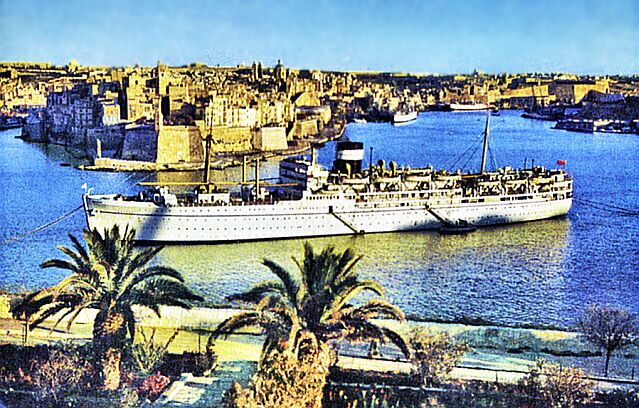
A
postcard of the MS Dunera in
She was taken to the Palmers Hepburn & Co
shipyards on the River Tyne to make her suitable to operate exclusively as an
education cruise ship. Upon completion she was reregistered at 12,620 GRT, and she
accommodated 190 passengers in cabins and 800 in her upgraded dormitories. She
departed on her first 14 day cruise in April 1961 and she continued her duties
as a floating school for the next six years until she became unprofitable and
was sold the breakers in 1967. She arrived at the Revalorizacion de Materiales SA yards in
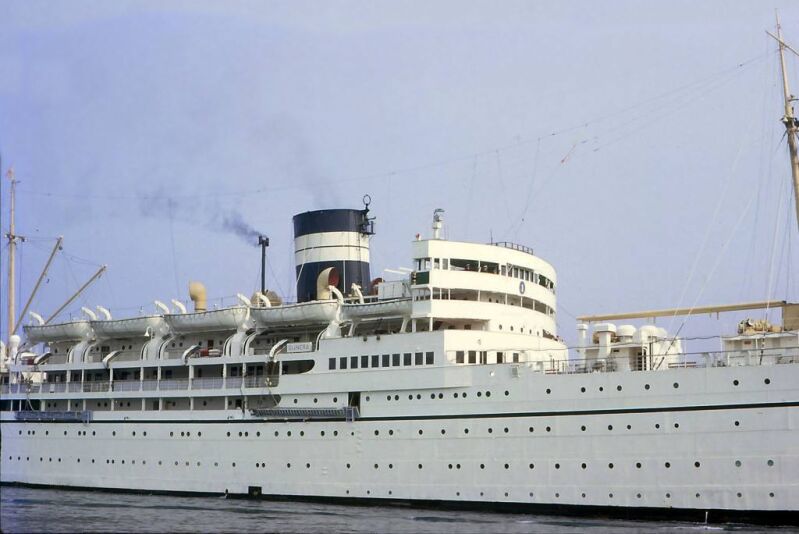
This is a superb close up image of the
superstructure during MS Dunera finest of days
From the author’s private collection
– purchased part of a photo bundle in 1984
******************************
3. Ettric
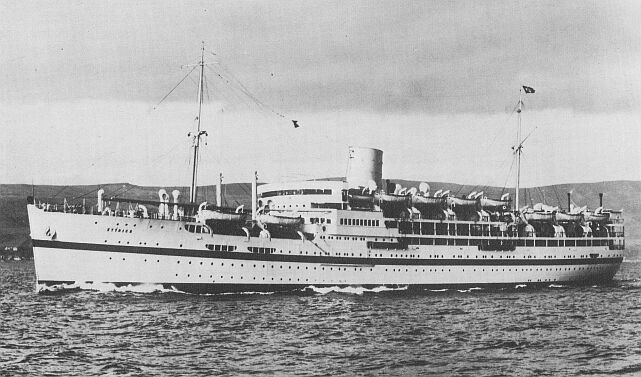
P&O’s liner MS Ettrick
MS Ettrick was built to be managed by P&O Lines as a permanent troopship, and she was also built by Barclay Curle & Co, Glasgow – Yard 669. 11,279 GRT
She was launched on August 25, 1938 and
completed on December 12. She was delivered and departed on her maiden voyage
on January 13, 1939, which was a cruise from Southampton to the
Unlike her older sister, she and her next
sister the
Her tragic end.
Whilst she was on her homeward voyage from
North Africa to Southampton, on November 15, 1942 HMS Ettrick was torpedoed by
the German submarine “U 155” and she sadly sunk near
******************************
4. Devonshire
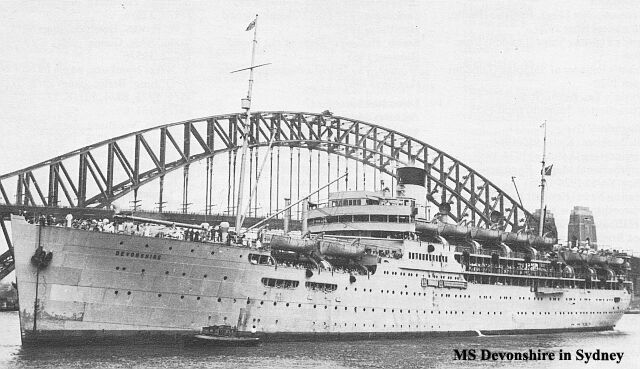
Troop
ship HMS Devonshire is seen here in Sydney Australia
She was launched on December 20, 1938, and
completed in July 1939. Like her sister she would undertake a cruise first, and
then her maiden troop voyage departed from Southampton on August 11, 1939,
sailing to
The Devonshire would spend most of the war
years transporting Australian troops to the Far East, Africa, Middle East and
the
Like the Dunera she carried troops to the Far
East and
Obtained by British India :
 In 1962, Devonshire was officially obtained by
In 1962, Devonshire was officially obtained by
However, like her sister the Dunera which was
also sold in 1967, the Devonia was sold to Italian breaker. She arrived at
The first of the quartet, the MS Dilwara would
continue to sail on for a few more years yet, as she outlived all her younger
sisters. Read her story on “Part Two” – MS Kuala
Lumpur.
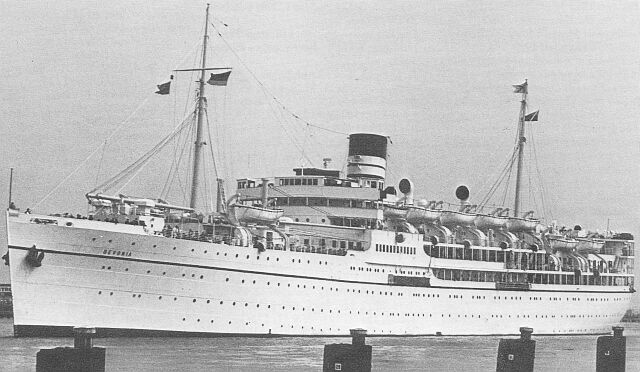
She
is seen here looking very smart and renamed as the MS Devonia
******************************
5. Kuala Lumpur

ENTER … Part Two
The China Navigation Co - MS Kuala Lumpur, ex Dilwara
“Blue Water Liners sailing to the
distant shores.
I watched them come, I watched them go and I watched them die.”
Where you
will discover around 680 Classic Passenger & Passenger-Cargo Liners!
ssMaritime.com & ssMaritime.net
Where the
ships of the past make history & the 1914
built MV Doulos Story
Please Note: ssmaritime and
associated sites are 100% non-commercial and the author does not seek funding
or favours and never have and never will.
Photographs
on ssmaritime and associate pages are either by the author or from the
author’s private collection. In addition there are some images and
photographs that have been provided by Shipping Companies or private
photographers or collectors. Credit is given to all contributors, however,
there are some photographs provided to me without details regarding the
photographer or owner concerned. Therefore, I hereby invite if owners of these
images would be so kind to make them-selves known to me (my email address can
be found at the bottom of the page on www.ssmaritime.com), in order that due credit may be given.
ssMaritime is owned & © Copyright by Reuben Goossens - All Rights Reserved
